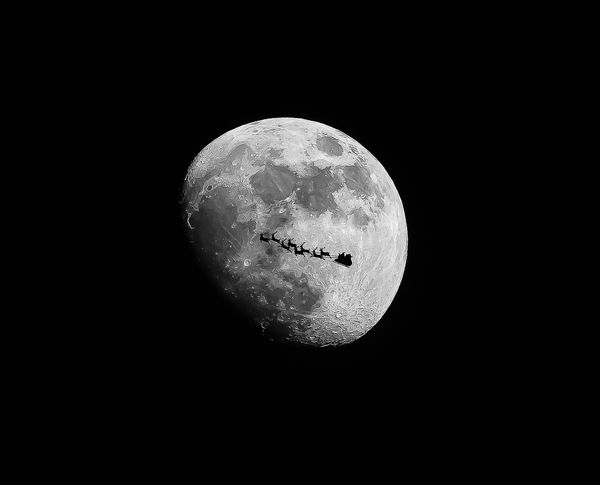Help with Moon Photo
Oct 3, 2020 19:40:27 #
When a lens is focused at infinity it’s depth of field is from its hyperfocal distance to infinity.
Oct 3, 2020 19:41:07 #
When a lens is focused at infinity it’s depth of field is from its hyperfocal distance to infinity.
Oct 3, 2020 23:49:33 #
Reuss Griffiths
Loc: Ravenna, Ohio
The truth of the matter in photographing the full moon is that there is nothing sharp in the image to see let alone focus on. The only thing sharp in any image of the moon are the shadows cast by craters due to an oblique angle of the sun. Almost all of the lunar features are covered in a thick layer of dust so even if you were much closer with the sun directly behind you, it would look the same. The most distinct features on a full-moon are the darker mare. The boundaries between the mare and the lighter highlands are in reality, not sharp so again, a dull looking image.
Oct 16, 2020 15:20:00 #
I find when I take moon pix, I get a better shot if I manual focus, give that a try just for the heck of it. Remember on a full moon, your shooting the reflection of the sun, so less ISO etc.
Nov 13, 2020 21:43:11 #
I also shot the full moon couple of weeks back. My settings were ISO500, 1/200 sec, F/6 and focal length 500mm. The camera was on a tripod. Got a nice sharp image of the full yellowish moon showing craters. Adjusted the Hue and Saturation to get a picture close to what I saw with the naked eye...
Nov 14, 2020 20:20:15 #
Pick a time when moon is either in half or quarter phase. A full moon is difficult with little contrast or any sharp lines.
Dec 12, 2020 23:19:15 #
I have gotten some decent shot using the following.
Manual focus and settings.
ISO 100.
f/11.
100th sec.
600mm lens.
Tripod and remote shutter release.
I have SLR that also has screen display and I focus using the screen.
Manual focus and settings.
ISO 100.
f/11.
100th sec.
600mm lens.
Tripod and remote shutter release.
I have SLR that also has screen display and I focus using the screen.
Feb 6, 2021 09:46:02 #
gvarner
Loc: Central Oregon Coast
Maybe pre-focus on a far distant object in good light and mark the spot with tape. Then use that to manual focus on the moon. For most lenses, a focus at infinity falls about an eighth of an inch short of the infinity mark.
Feb 7, 2021 21:24:40 #
alberio wrote:
Our eyes tend to compensate for poor "seeing ... (show quote)
As a land surveyor that worked in the field before GPS surveying, I can agree with everything alberio said. In the days of optical survey instruments, which are still used by the way, we sometimes had to take shots from section corner to section corner that were one mile. We would arrive at the job site in the dark, s half hour before sunup. On a normal California summer morning the temperature will go from 60F at sunup to 80 in a few minutes. Looking through a theodolite scope at a target a mile away once the air starts to warm the target start jumping around so much it's impossible to take the shot. There's nothing to get a focus lock on. It's the same shooting planets or the moon only worse. In surveying you just need a line and a distance. With photography you need resolution which is a lot harder to come by.
All this is to say, if you want clear shots you need cold, still air. You need the combination of the right light on the moon, a cold night and still air. And you need a night when there's no clouds. There's not anything you can do about it. It just is.
Feb 9, 2021 07:16:19 #
qasas3251 wrote:
I have been photo graphing the Moon and I can't se... (show quote)
The photos are the same.
Full moon seems bad only because there is not much contrast during a full moon. Whereas in the other image, the side lighting of the craters create contrasting shadows and add to the illusion of being sharper.
If the camera is having focus problems because of this low contrast, focus on the rim of the moon, so it contrast the dark sky. Weather also plays havoc in night sky photos so be sure you have the best weather.
Also try several images with slightly different focus (focus stack) and experiment with a haze filter or polarizer.
Feb 10, 2021 09:57:06 #
"...if you want clear shots you need cold, still air... tenor saxophonist 10MPlayer actually has the most germane post in this thread so far... As one who also has experience working on a surveying team... A theodolite is subject to atmospheric convection waves. In case you don't realize it, "air" is "fluid". Gasses are also fluids. Since air is a gas, it flows... when heated it rises forming convection waves... the closer to sea level the more pronounced the waves. Any freshman physics student is taught the basic fluid mechanics... Without this knowledge most are pretty much clueless...
Oh, in case you believe that I'm simply "blowing hot air" you might appreciate the fact that Haleakala mountain in Hawaii is over 10,000 feet above sea level... Atop the Haleakala mountain in Hawaii, is a $344-million observatory, the 4-metre Daniel K. Inouye Solar Telescope. That said, NASA has the best idea for photographing the lunar surface it's called the "Hubble", this observatory, is the first major optical telescope to be placed in space, the ultimate mountaintop.
Yep, just like in sports photography... the cardinal rule is "KNOW YOUR SPORT!"
I understand that Hawaii is epic this time of year and with the pandemic raging, United Airlines has some attractive pricing...
https://www.skylinehawaii.com/maui/haleakala-classic-sunrise-tour
Enjoy!
Oh, in case you believe that I'm simply "blowing hot air" you might appreciate the fact that Haleakala mountain in Hawaii is over 10,000 feet above sea level... Atop the Haleakala mountain in Hawaii, is a $344-million observatory, the 4-metre Daniel K. Inouye Solar Telescope. That said, NASA has the best idea for photographing the lunar surface it's called the "Hubble", this observatory, is the first major optical telescope to be placed in space, the ultimate mountaintop.
Yep, just like in sports photography... the cardinal rule is "KNOW YOUR SPORT!"
I understand that Hawaii is epic this time of year and with the pandemic raging, United Airlines has some attractive pricing...
https://www.skylinehawaii.com/maui/haleakala-classic-sunrise-tour
Enjoy!
Feb 16, 2021 12:20:02 #
I found a rule that works awesome as a base for taking shots of the moon. Like what was said above the moon is a lot brighter than it looks to our eye. The rule is lunar 11 what you do is use f11 then your shutter speed is 25 over your iso. for instance you set it at f11 then your iso at 100. your shutter speed will be 1/125. It's a good starting point I've found. Also on your camera use the live screen view to set the focus with the magnification at its highest will help on the sharpness. you might have to slow your shutter speed down a lot to see it but then you can turn it back up to take the picture. use your phone app to shoot the picture to avoid shake. or altering the focus. I hope this helps.
Feb 22, 2021 14:39:19 #
littlebug
Loc: woburn ma
That's a lot better than mine, I'm going to follow some of the quotes .
I like your shots .
I like your shots .
Mar 5, 2021 13:19:43 #
I think the technical discussions are important above. My 2 cents worth is this: The air has to be cool and the atmosphere has to be clear. (Living in California, that is not always possible.) The night has to be dark...ie the sun cannot just have set with a bit of light left (I forget the term...blue hour maybe?). The longer the lens the better. The moon is quite bright so the ISO needs to be low. For me, having a mirrorless helped immensely since I am not an expert at moon shots and was able to see what I was going to get. I focused on infinity. Shoot in raw so you can do more processing (understanding others will disagree.) In post, tighten up the contrast, sharpness, etc. I also switched the moon to B&W which also seemed to help.
I shot this handheld but used a stationary object to shoot in a barricade position to hold my shot steady. A tripod obviously will work as well. If you are on tripod, turn off image stabilization. This was shot at ISO 200, F6.7, 1/350 sec at 400 mm (800 mm equivalent FF). And I think it worked out ok. FWIIW, I don't find moon shots with nothing else in the shot all that interesting...so maybe get a few shots to embed into other photos or come up with something fun.
I was thinking, for a full moon shot, maybe pay attention to the histogram and do the ETTR to make sure no blown out areas of the photo?
I shot this handheld but used a stationary object to shoot in a barricade position to hold my shot steady. A tripod obviously will work as well. If you are on tripod, turn off image stabilization. This was shot at ISO 200, F6.7, 1/350 sec at 400 mm (800 mm equivalent FF). And I think it worked out ok. FWIIW, I don't find moon shots with nothing else in the shot all that interesting...so maybe get a few shots to embed into other photos or come up with something fun.
I was thinking, for a full moon shot, maybe pay attention to the histogram and do the ETTR to make sure no blown out areas of the photo?

Mar 5, 2021 14:22:57 #
qasas3251 wrote:
I have been photo graphing the Moon and I can't se... (show quote)
Maybe a few issues going on here. My suggestion is shoot when it's cool out (Less heat wave distortion) and when the moon is high in the sky (Less atmosphere to shoot through). Elevation also helps with atmospheric distortion. I see allot of noise in the full moon shot - not sure why that would be so prominent since the setting are very close for both images. Tripod may help since you can lower your ISO and shutter speed a bit (Looks like you have some wiggle room there).
If you want to reply, then register here. Registration is free and your account is created instantly, so you can post right away.







